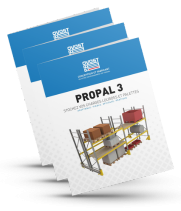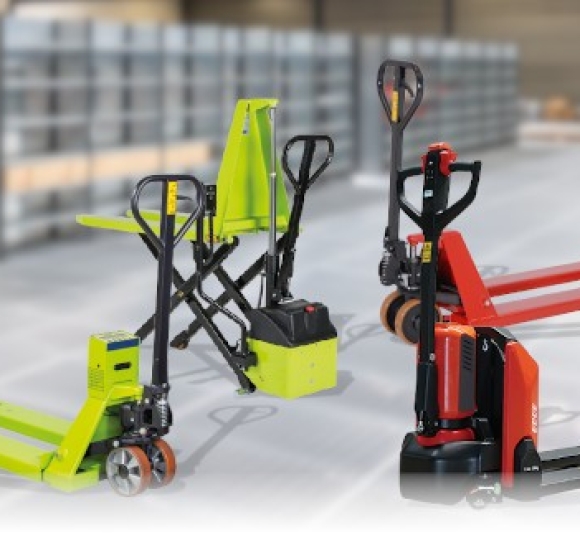
How to choose your pallet truck?
The pallet truck enables palletized loads to be handled on the ground, and is one of the most widely used tools in the world. Whether in stores, logistics warehouses or transportation, pallet trucks can be found in many different fields and working environments.
So it's only natural that pallet transport should be one of the key tasks in warehouses and storage areas, as it affects the protection of your goods, the rate of dispatch and the safety of your employees. That's why it's important to find out about the different criteria for choosing a pallet truck, so you can find the model best suited to your needs.
Pallet truck uses and applications
Before comparing the different pallet truck models to find a specific one, you'll first need to define its conditions of use:
- Working environment: will the pallet truck be used indoors or outdoors? If indoors, is the environment damp or dirty?
- Goods to be transported: size, accessibility, gripping height and total load;
- Usage: how often will your pallet truck be used, and by how many operators? Do palletized goods also need to be weighed?
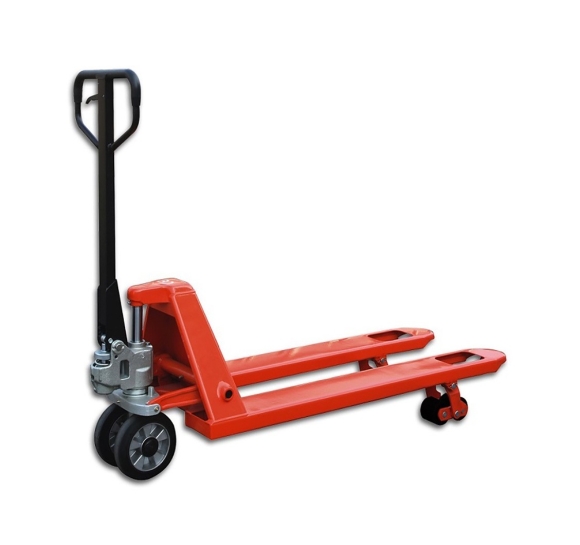
The different types of pallet trucks
There are 3 types of pallet truck: manual, semi-electric and electric. To make your choice, you need to take into account the type and frequency of handling.
Manual pallet trucks
Perfect for small-scale handling or occasional loads in the workshop or store, the manual pallet truck makes it quick and easy to store supplies and goods. Lightweight, they are easy to store in a delivery truck.
Its operation relies on the strength of the operator. The pallet truck is lifted by means of a hand-pumped handle. To move the pallet truck, simply pull the tiller. No special certification is required to operate this machine. However, prevention of accidents and falling loads is essential to ensure the safety of the operator and others.
Be careful, however, with the slope of the floor in the working environment: it should be less than 10%, so as not to prevent the pallet truck from being towed.
Semi-electric pallet trucks
There are two types of semi-electric pallet truck: those with electric lifting and manual movement; and those with manual lifting and electric movement. These are also known as hybrid pallet trucks. Their semi-automated operation takes the load off the operator, while speeding up the pace of work. Faster and more efficient than a manual pallet truck, yet less expensive than an electric model, hybrid pallet trucks are an interesting compromise when it comes to investment.
Electric pallet trucks
On an electric pallet truck, both the movement of the truck and the lifting of its forks are electrically assisted. Movement is powered by an electric traction motor operated from the tiller arm. Lifting is by means of a hydraulic pump driven by the electric motor.
This eliminates the need for any physical effort on the part of the operator, thus improving work rate and productivity. As a result, handling operations can be carried out with greater load intensity and over longer distances. Ideal for companies with very intensive handling activities.
Of course, the investment in an electric pallet truck is more substantial because of the undeniable advantages it brings. They also require maintenance, and must be inspected at regular intervals by an approved body. Before using an electric pallet truck, you should also check that it is in good working order: brakes, emergency stop button, battery, as well as the various controls.
Comparison of the three models
| Manual pallet truck | Semi-electric pallet truck | Electric pallet truck |
Features
|
Features
|
Features
|
Specific pallet trucks
Among electric, semi-electric and manual pallet trucks, there are still many specific models designed to adapt to particular uses or loads:
- With all parts galvanized, to ensure longevity and robustness in damp environments;
- With short, long or adjustable forks to adapt to specific half-pallets or pallets;
- With high lift heights for depositing pallets stored high up;
- For handling specific loads: drums, reels, containers, etc
If you have any of these specific needs, finding out more about pallet truck features will help you find the right model to meet your requirements.
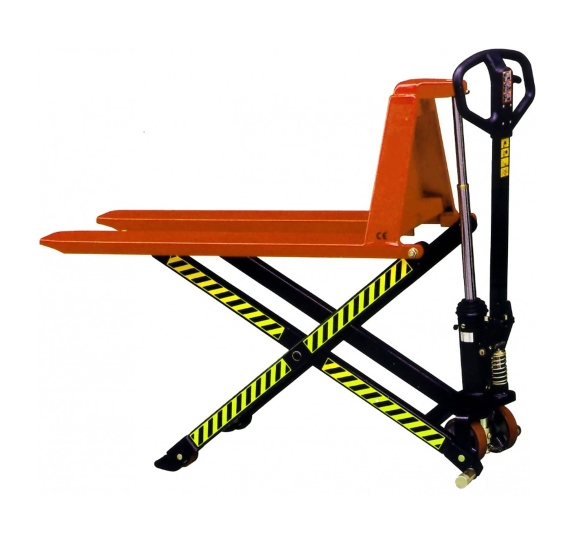
Features: lift height
The lifting height of your pallet truck is a key factor in its choice. Goods are lifted to the ideal height, reducing the effort required of your operators and reducing the risk of RSI (musculoskeletal disorders).
Standard models raise goods by around 20 cm. If your activity requires a higher lifting height, our high-lift pallet trucks equipped with scissor lifts make it easier to deposit and handle pallets at gripping height.
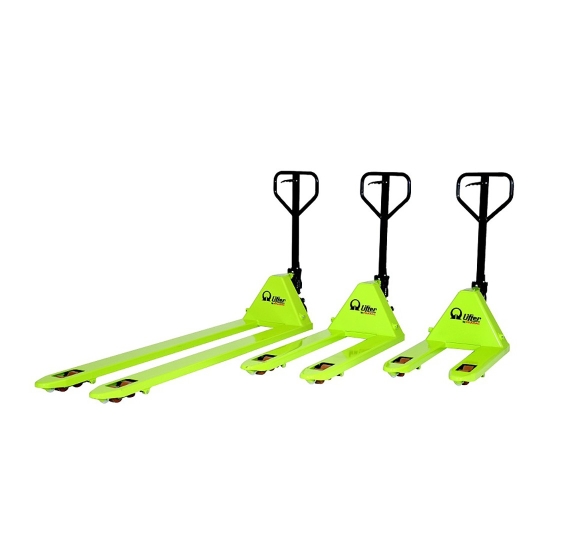
Features: fork size and type
The choice of fork size and type depends on the type of goods you wish to transport. In fact, the size of the pallets you'll be using is crucial.
Which fork size for which type of pallet?
- Small and half pallets: short forks 800 mm;
- Standard-size pallets: standard-length forks 1150mm, perfectly adapted to European standard pallets;
- Large pallets: long forks 1800mm.
It's also worth noting that the length of the forks determines the type and direction of pallet pick-up: 800mm forks allow pallets to be picked up widthways only, while 950 and 1150mm forks also allow pallets to be picked up lengthways.
Features: wheels and rollers
A pallet truck is equipped with 2 types of wheels:
- Two small wheels, called rollers, located under the forks for easy sliding under the pallet. They do not swivel;
- A larger steering wheel under the tiller. It pivots to maneuver the pallet truck.
To find the right wheels and rollers for your pallet truck, you'll need to take into account your working environment and the ground on which the truck will be travelling :/
- Rubber: silent, they provide good grip on uneven (shock-absorbing), wet and slippery industrial floors; marking the ground, they can leave marks. They are ideal for outdoor use;
- Polyurethane: they do not stain floors, and their low rolling resistance makes them particularly suitable for sensitive, soft floors;
- Nylon: noisier, they provide optimum driving performance on hard floors and make it easier to move heavy loads; this type of wheel is widely used in the food and pharmaceutical industries).
Weighing pallet trucks
Pallet trucks can be used for repetitive handling operations, particularly in logistics warehouses. When loads need to be weighed, the use of a weighing pallet truck will save a considerable amount of time by weighing the loads lifted and allowing them to be added together. Weighing pallet trucks can also be fitted with printers to keep track of loads handled.
Operating a pallet truck
Handling heavy loads is a risky activity for both the employee and the goods, and requires a certain amount of know-how on the part of the operator. The operator must therefore be trained in-house to operate handling equipment. Safety shoes must also be worn.
To maneuver a pallet truck, the operator can adopt several positions:
- Accompanying: the operator stands and walks while pulling the pallet truck;
- Platform: the pallet truck is equipped with a platform serving as a driving position, on which the operator stands;
- Seated: a seat is integrated into the pallet truck, either facing the forks or in a lateral position.

